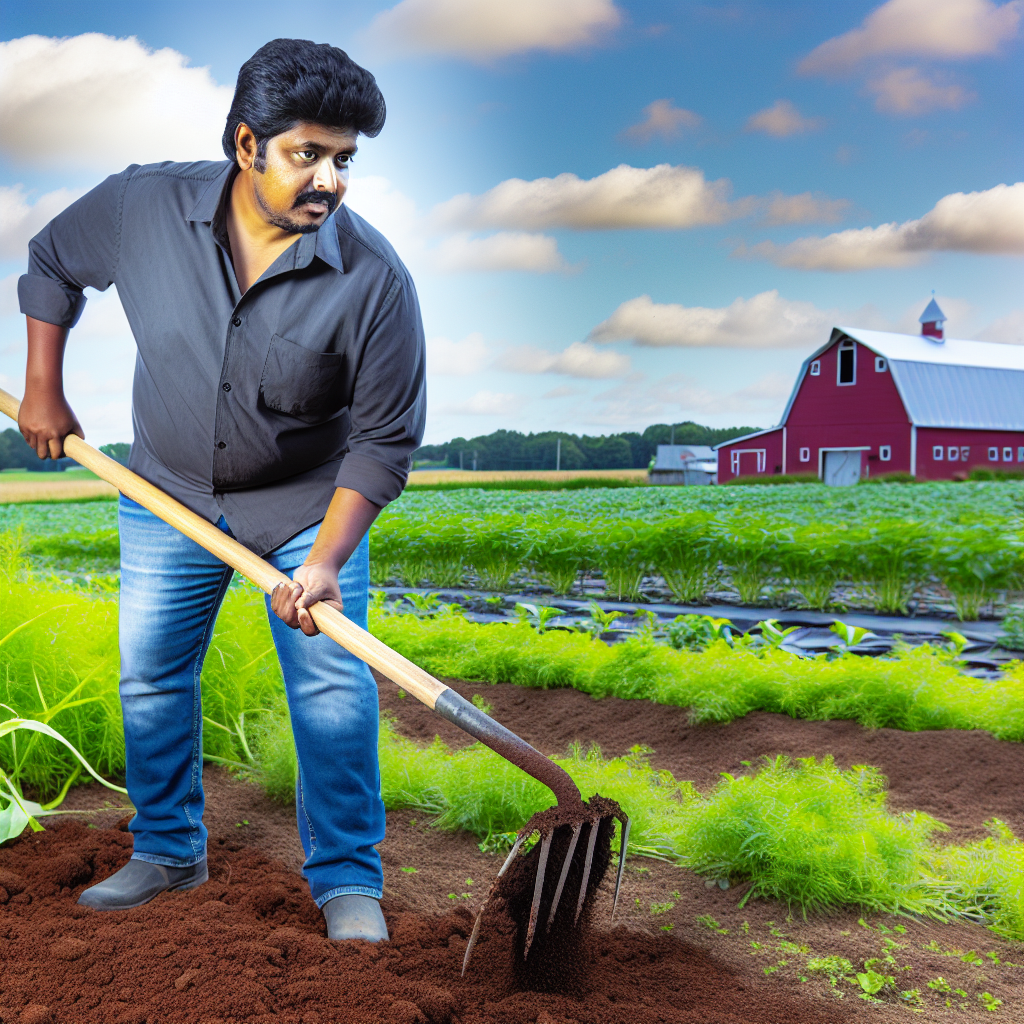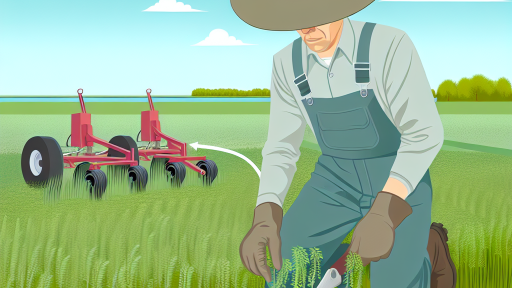Understanding Soil Composition and Its Importance in Agriculture
Defining Soil Composition
SoiL composition refers to the mixture of organic matter, minerals, gases, liquids, and organisms present in soil.
This composition directly affects plant growth and agricultural productivity.
Furthermore, soil consists of varying proportions of sand, silt, and clay.
Each component influences water retention and nutrient availability.
The Role of Organic Matter
Organic matter is crucial for enhancing soil fertility.
It consists of decomposed plants and animal materials.
This material improves soil structure and promotes beneficial microbial activity.
As a result, crops benefit from improved nutrient availability and water retention.
Mineral Content and Its Significance
Minerals provide essential nutrients for plants.
They include macronutrients such as nitrogen, phosphorus, and potassium.
Micronutrients like iron, manganese, and zinc are also vital.
These minerals help strengthen plants and boost their growth.
The Importance of Soil pH
Soil pH significantly influences nutrient availability.
Acidic or alkaline soils may prevent plants from absorbing nutrients efficiently.
Thus, maintaining a neutral pH range is essential for optimal growth.
Transform Your Agribusiness
Unlock your farm's potential with expert advice tailored to your needs. Get actionable steps that drive real results.
Get StartedFarmers can adjust soil pH through various natural amendments.
Microscopic Organisms and Soil Health
Living organisms within the soil contribute to its overall health.
Bacteria, fungi, and earthworms improve nutrient cycling and structure.
These organisms help decompose organic matter, releasing essential nutrients.
Promoting a diverse microbial community enhances soil fertility.
Environmental Impact of Soil Composition
Healthy soil composition supports sustainable farming practices.
It reduces the need for chemical fertilizers and pesticides.
Moreover, it promotes biodiversity and protects ecosystems.
Ultimately, maintaining soil health leads to environmental benefits and productivity.
The Role of Organic Matter in Enhancing Soil Fertility
Defining Organic Matter
Organic matter consists of decomposed plant and animal materials.
It enriches soil by providing essential nutrients for crops.
Furthermore, organic matter improves soil structure.
Benefits of Organic Matter
Organic matter boosts moisture retention in the soil.
It enhances the soil’s ability to hold nutrients.
This process leads to improved crop yields over time.
Additionally, organic matter encourages microbial activity, which is vital for soil health.
Ways to Increase Organic Matter
Farmers can boost organic matter through various methods.
- Incorporating cover crops into the farming system
- Applying compost made from plant and animal waste
- Using crop rotation techniques to enhance soil diversity
These methods contribute significantly to soil fertility.
Examples of Effective Practices
Planting legumes as cover crops can add nitrogen to the soil.
This practice benefits subsequent cropping cycles by enhancing soil fertility.
Moreover, regular application of well-decomposed compost enriches soil quality.
Monitoring Soil Health
Regular soil testing helps track organic matter levels.
This data guides farmers in making informed adjustments.
Ultimately, maintaining healthy soil enhances farming sustainability.
Showcase Your Farming Business
Publish your professional farming services profile on our blog for a one-time fee of $200 and reach a dedicated audience of farmers and agribusiness owners.
Publish Your ProfileComposting: Techniques and Benefits for Natural Fertility Boost
Introduction to Composting
Composting is a natural process that turns organic waste into valuable soil amendment.
This technique improves soil fertility effectively without synthetic chemicals.
Farmers can enhance their soil’s health by utilizing composting methods.
Composting Techniques
There are several effective composting techniques available for farmers.
Hot composting is one popular method that encourages rapid decomposing.
This technique requires managing moisture, aeration, and temperature levels.
Another method is cold composting, which is simpler but takes longer.
This approach allows organic materials to break down naturally over time.
Hot Composting Steps
Start by selecting a suitable location for your compost pile.
Collect green materials like kitchen scraps and brown materials such as dried leaves.
Layer the materials to support airflow and microbial activity.
Turn the compost regularly to maintain oxygen levels and speed decomposition.
Cold Composting Steps
Build a pile of organic materials in a designated area of your farm.
Water the pile occasionally to help maintain moisture levels.
Leave the pile undisturbed, allowing it to decompose over several months.
Benefits of Composting
Composting offers numerous benefits for enhancing soil fertility naturally.
First, it enriches the soil with essential nutrients, supporting plant growth.
This process also improves soil structure, allowing better water retention.
Moreover, composting aids in disease suppression and pest management.
Finally, it reduces waste by recycling organic materials from the farm.
Choosing the Right Materials
Selecting the proper materials is crucial for effective composting.
Use a balanced mix of green and brown materials for optimal results.
Greens include nitrogen-rich items like vegetable scraps and grass clippings.
On the other hand, browns consist of carbon-rich materials like dry leaves and straw.
Monitoring the Composting Process
Regularly monitoring your compost ensures its success.
Check the moisture level; it should feel like a damp sponge.
Also, keep an eye on the temperature; it should reach at least 130°F to kill pathogens.
Turning the compost every few weeks will enhance aeration and speed up decomposition.
Embracing Composting for Sustainable Farming
Using compost can dramatically improve soil fertility on farms.
Farmers should embrace composting for a sustainable and eco-friendly approach.
Ultimately, healthy soil leads to higher crop yields and supports overall ecosystem health.
Explore Further: Integrating AI Solutions In Crop Analytics
Cover Crops: Selecting and Implementing for Soil Enrichment
Overview of Cover Crops
Cover crops serve multiple purposes on a farm.
They improve soil health and prevent erosion.
Additionally, these crops enhance nutrient cycling.
Benefits of Using Cover Crops
Cover crops offer numerous advantages for soil fertility.
They suppress weeds, minimizing the need for herbicides.
Moreover, cover crops can fix atmospheric nitrogen.
This process enriches the soil for subsequent crops.
Furthermore, they improve soil structure and water retention.
Showcase Your Farming Business
Publish your professional farming services profile on our blog for a one-time fee of $200 and reach a dedicated audience of farmers and agribusiness owners.
Publish Your ProfileSelecting the Right Cover Crops
Choosing appropriate cover crops is crucial for success.
Consider the climate and soil conditions specific to your farm.
Additionally, select crops based on the primary cash crops.
Some common options include clover, rye, and vetch.
Also, think about the biomass production potential of each crop.
Implementing Cover Crops Effectively
Proper implementation maximizes the benefits of cover crops.
First, plant cover crops during the off-season.
Next, ensure timely planting before the first frost.
When using legumes, manage them to promote nitrogen fixation.
Lastly, terminate cover crops strategically before planting cash crops.
Managing Cover Crop Growth
Monitoring cover crop growth is essential for success.
Check for pests and diseases that could impact health.
Additionally, manage soil moisture levels throughout the growing season.
Use regular assessments to determine biomass accumulation.
Assessing the Impact on Soil Fertility
Evaluating the impact of cover crops is vital.
Conduct soil tests to measure nutrient levels periodically.
Compare performance metrics from before and after implementation.
This data will guide future planting decisions.
Gain More Insights: Crop Protection Strategies Through Disease Forecasting
Crop Rotation: Strategies for Maximizing Soil Nutrients
Understanding Crop Rotation
Crop rotation involves alternating different crops in specific sequences.
This method prevents soil nutrient depletion from a single crop type.
Additionally, it disrupts pest and weed cycles effectively.
Benefits of Crop Rotation
Enhanced soil fertility is one of the main benefits.
Different plants utilize various nutrients differently.
This diversity helps balance nutrient levels in the soil.
Moreover, crop rotation improves overall soil structure.
Choosing the Right Crops
Selecting complementary crops is crucial for successful rotation.
Legumes, such as beans and peas, enrich nitrogen levels.
In contrast, deep-rooted plants help access nutrients from lower soil layers.
For example, rotating legumes with cereal crops maximizes nutrient uptake.
Creating a Rotation Plan
A solid rotation plan supports maintaining soil health.
First, assess the specific soil nutrient needs.
Next, schedule crops according to their nutrient requirements.
Finally, ensure the plan allows sufficient recovery time for each crop.
Implementing Crop Rotation
Start by planting different crops in designated plot areas.
Rotate crops based on the growing seasons and soil tests.
This adaptability can lead to significant long-term gains in soil health.
Evaluating Crop Rotation Effectiveness
Regularly assess the soil quality after implementing the rotation.
Check for improvements in nutrient levels and soil structure.
Also, monitor changes in pest and weed populations.
Showcase Your Farming Business
Publish your professional farming services profile on our blog for a one-time fee of $200 and reach a dedicated audience of farmers and agribusiness owners.
Publish Your ProfileThis evaluation ensures the effectiveness of the rotation strategy.
See Related Content: Climate Control for Aquaponic Operations

Using Green Manures: Benefits and Application Methods
Understanding Green Manures
Green manures are cover crops grown to improve soil health.
They promote soil fertility by adding organic matter.
Furthermore, they enhance microbial activity in the soil.
These plants are usually turned into the soil before maturity.
Benefits of Green Manures
Green manures offer numerous advantages for farmers.
- They boost soil nutrient levels, particularly nitrogen.
- They improve soil structure and aeration.
- They help suppress weeds effectively.
- They reduce erosion risks on sloped land.
- Additionally, they can attract beneficial insects.
Choosing the Right Green Manure
Selecting the appropriate green manure depends on various factors.
Consider current soil conditions and crop rotation plans.
Popular options include clover, vetch, and rye.
Additionally, legumes are excellent choices for nitrogen fixation.
Application Methods of Green Manures
Proper application techniques maximize the benefits of green manures.
- Sow seeds in the fall to establish them before winter.
- Incorporate the plants into the soil when they reach flowering.
- Ensure timely incorporation to prevent excessive decomposition.
- Use a no-till method if possible for less disruption.
Post-Application Considerations
After incorporating green manures, monitor soil conditions.
Testing soil regularly helps evaluate nutrient levels.
Adjust future applications based on test results for optimal growth.
Finally, always combine green manures with crop rotation for best results.
You Might Also Like: Comparing Hydroponics and Aquaponics
Natural Soil Amendments: Types and How to Use Them Effectively
Types of Natural Soil Amendments
Natural soil amendments enrich the soil biologically and chemically.
They improve soil structure, fertility, and moisture retention.
Common types include compost, manure, cover crops, and biochar.
Compost
Compost is decomposed organic matter rich in nutrients.
You can make compost at home using kitchen scraps and yard waste.
Apply it directly to the soil to enhance nutrient content.
Compost also improves soil structure and promotes beneficial microorganisms.
Manure
Manure provides an excellent source of nutrients for crops.
Farm animals, such as cows and chickens, produce high-quality manure.
Allow the manure to mature before applying it to avoid burning plants.
Spread it evenly to prevent nutrient runoff and maintain soil balance.
Cover Crops
Cover crops are grown primarily to benefit the soil.
They prevent soil erosion, suppress weeds, and enhance organic matter.
Common cover crops include clover, rye, and vetch.
After growing, till them into the soil to improve fertility.
Biochar
Biochar is a charcoal-like substance created from organic materials.
This amendment improves soil health by enhancing water retention.
It also increases the availability of nutrients for plants.
Incorporate biochar into the soil before planting for best results.
Using Soil Amendments Effectively
Soil amendments should be used based on soil needs.
Conduct soil tests to determine nutrient deficiencies.
Combine multiple amendments for a well-balanced approach.
Application Techniques
Spread amendments evenly across the soil surface.
Showcase Your Farming Business
Publish your professional farming services profile on our blog for a one-time fee of $200 and reach a dedicated audience of farmers and agribusiness owners.
Publish Your ProfileTilling helps incorporate amendments into the soil effectively.
Avoid over-application to prevent soil toxicity.
Timing for Application
Apply soil amendments before planting new crops.
Fall is an ideal time for incorporating compost and manure.
This allows nutrients to integrate into the soil over winter.
Monitoring Soil Health
Regularly monitor soil health to gauge effectiveness.
Observe plant growth and response to amendments.
Adjust the types and amounts of amendments as necessary.
Pest and Weed Management
Impact of Pests and Weeds
Pests and weeds negatively affect crop yields.
They compete for nutrients, water, and sunlight.
Consequently, managing them is crucial for soil health.
Effective management retains fertility and enhances productivity.
Sustainable Control Methods
Utilize integrated pest management strategies for sustainability.
This approach combines biological, cultural, and mechanical methods.
Encourage natural predators like ladybugs and lacewings.
These predators effectively control pest populations.
Additionally, crop rotation disrupts pest life cycles.
Organic Weed Control Techniques
Weed management through mulching is beneficial.
Mulch suppresses weed growth and retains soil moisture.
Cover crops also improve soil structure and fertility.
They outcompete weeds for resources while enriching soil.
Finally, hand-pulling weeds remains an effective option.
Utilizing Technology
Modern technology aids in pest and weed management.
Drones can monitor crop health and identify problem areas.
Additionally, precision agriculture tools optimize inputs.
These technologies enhance overall farm efficiency.
Education and Training
Farmers should seek education on sustainable practices.
Workshops and courses enhance knowledge and skills.
Connect with agricultural extension services for support.
They provide valuable resources and expert advice.
Ongoing education ensures farmers stay up-to-date.
Additional Resources
Managing Pests with Cover Crops – SARE
How to Sustainably Feed 10 Billion People by 2050, in 21 Charts …




